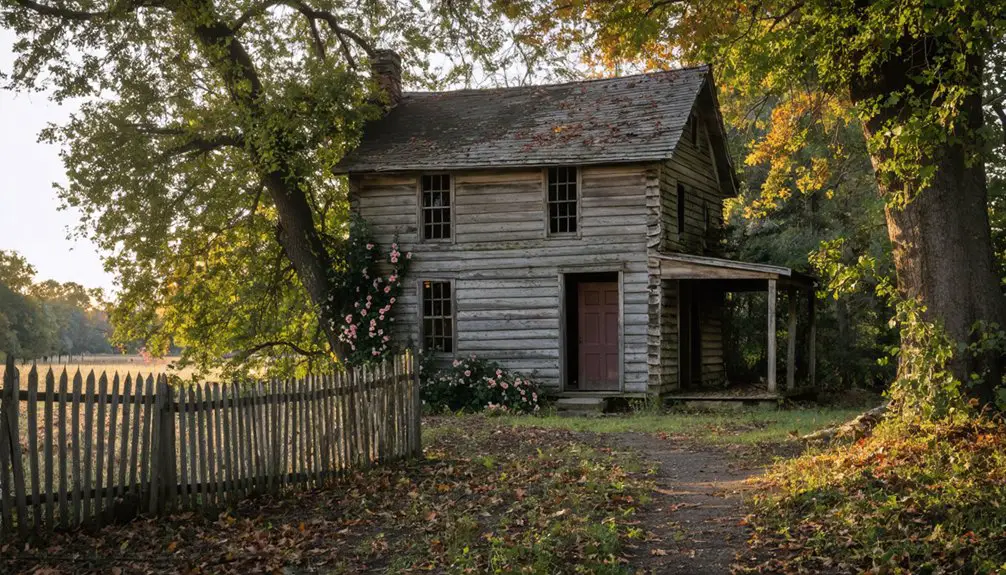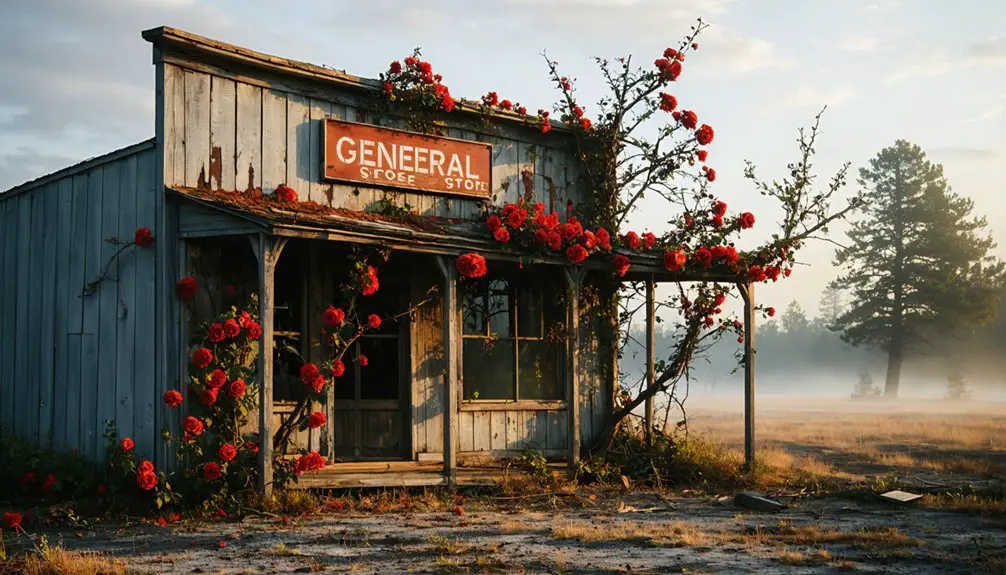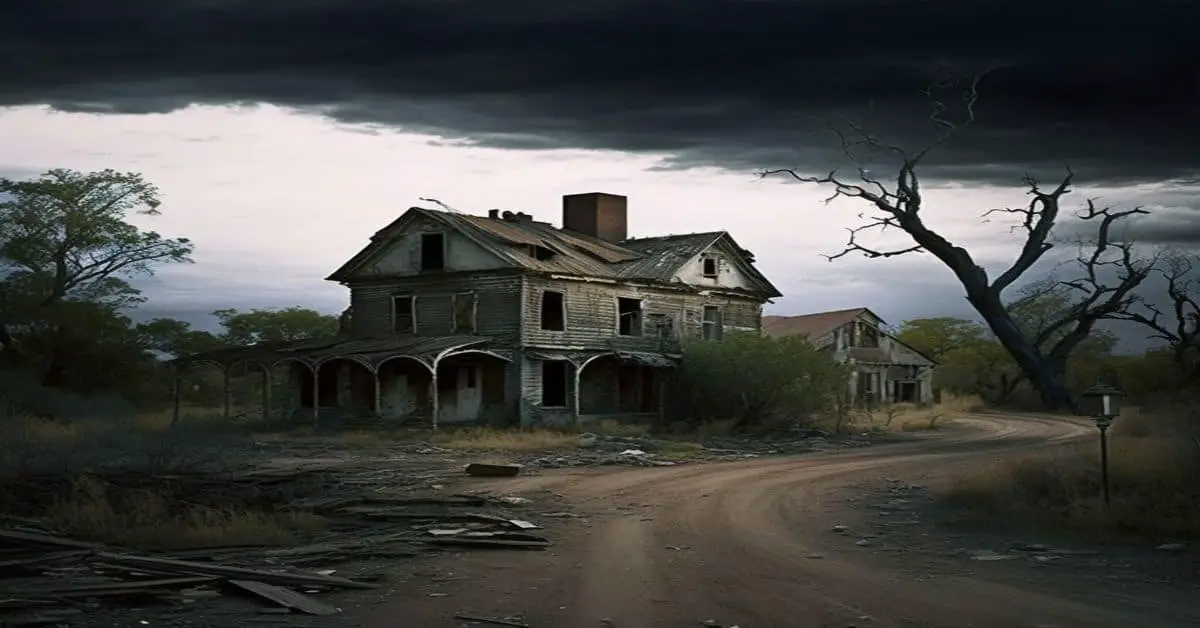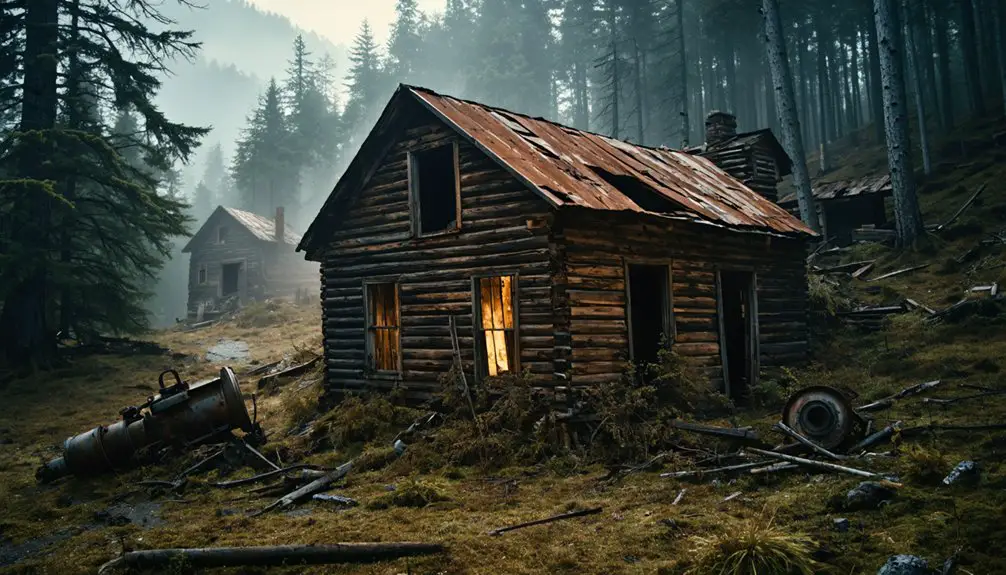You’ll find Blooming Rose nestled in Garrett County, Maryland at 653 meters above sea level. Named for its abundant wildflowers, this settlement attracted Revolutionary War veterans through Maryland’s land grant program in the late 18th century. By 1791, forty families called it home, but the Great Depression triggered its decline into a ghost town. Today, you can explore stone foundations, church ruins, and other landmarks that tell the story of this forgotten frontier community.
Key Takeaways
- Blooming Rose transitioned from a thriving Revolutionary War veteran settlement to a ghost town during the Great Depression.
- By 1960, the population declined to fewer than 200 residents, leading to closure of essential community services.
- Notable ruins include Daniel’s Pentecostal Church, stone foundations along Alberton Road Trail, and the abandoned church near the dam.
- The settlement’s decline stemmed from economic stagnation, lack of industrial development, and significant population migration.
- Historical structures like the Flory House foundation and Browning’s mill (operated until 1892) remain as evidence of the former community.
Origins of the Settlement’s Unique Name
While many Maryland settlements were named after landowners or industry, Blooming Rose earned its distinctive name from the abundant wildflowers that carpeted the landscape during its initial survey.
You’ll find its naming conventions reflect the vision of Reverend Jonathan Boucher, an early land speculator who officially designated his claim as “Blooming Rose.”
Unlike other regional places that sometimes incorporated indigenous terms, this name emerged purely from settler origins, emphasizing the area’s natural beauty and floral symbolism. The term “blooming” specifically highlighted the visual impact of flowers in full blossom rather than cultivated gardens.
This name choice aligned with common 18th-century practices where settlers used striking natural features to attract new residents and mark fresh beginnings in Maryland’s western frontier. The platform’s user-friendly navigation helps modern visitors explore the town’s historical sites. Today, the location’s name remains preserved through disambiguation pages that help researchers distinguish it from other similarly named places.
Early Pioneers and Revolutionary War Veterans
The establishment of Blooming Rose gained momentum through Maryland’s strategic land grant program following the Revolutionary War. You’ll find that veterans received varying allotments – 50 acres for soldiers and 200 acres for officers – primarily in Garrett County’s frontier regions.
Richard Hall, likely a Revolutionary War private, became the town’s first resident, paving the way for pioneer challenges that would test future settlers. Records of his service can be found in the Muster Rolls along with over 20,000 other Maryland troops who served from 1775-1783. Today, the scenic landscapes of this former settlement continue to captivate visitors exploring Garrett County’s history.
By 1791, about forty families had joined him, many of whom were veterans of both the Revolutionary War and Northwest Indian War.
These veteran contributions shaped Blooming Rose’s early character, as former soldiers sought peace in this remote area. Their military experience proved valuable in establishing security and social structure, while their land grants formed the foundation of the settlement’s initial development.
Geographic Location and Natural Features
You’ll find Blooming Rose situated at 653 meters above sea level in Maryland’s western Garrett County, where its position at 39.6507°N, 79.4533°W places it squarely in the Appalachian region.
The area’s mountainous terrain has made it a popular destination for outdoor enthusiasts. The town’s natural landscape features rugged, hilly terrain typical of the Allegheny Mountains, with mixed hardwood forests and abundant wildflowers that inspired its name. Modern visitors can explore these features using interactive maps available through digital platforms.
Its humid continental climate brings cold winters and warm summers, creating distinct seasonal patterns that influenced early agricultural activities and settlement development.
Elevation and Climate Patterns
Situated at an elevation of 653 meters (2,142 feet) above sea level, Blooming Rose’s location in western Maryland’s Garrett County places it firmly within the upland Appalachian Plateau region. The elevation effects create a distinct temperate oceanic climate, cooler than Maryland’s lower-lying areas. Near the coordinates 39 39 22 N, the landscape features several historic burial grounds that mark the area’s early settlements.
Like much of the region that contains 76,000 acres of public parks and forestland, the climate influence is particularly evident in:
- Year-round precipitation patterns supporting lush forests and historic wildflower growth
- Cool, wet summers and cold winters with significant snowfall
- Temperature variations moderated by the mountainous terrain
The town’s position at 39.6507°N latitude and 79.4533°W longitude experiences average temperatures lower than coastal Maryland, with 35-45 inches of annual precipitation.
This climate pattern shaped local development, affecting everything from agricultural seasons to transportation accessibility throughout Blooming Rose’s history.
Natural Landscape Features
Nestled within western Maryland’s rugged Appalachian terrain, Blooming Rose occupies a distinctive location near Friendsville in Garrett County at coordinates 39.65°N and 79.45°W.
You’ll find the ghost town amid a landscape of mixed hardwood forests at elevations between 2,043 and 2,142 feet above sea level.
The area’s wildflower diversity earned its memorable name, with native species still dotting the mountainous ridges and valleys, similar to the historic Bloomrose Church that served as a landmark for the region.
The ecological significance of this region extends beyond its flora, as you’ll discover pristine waterways, including the nearby Youghiogheny River with its scenic designation.
Small creeks and streams crisscross the terrain, supporting local wildlife and creating essential wetland habitats.
The untamed landscape remains largely undeveloped, preserving its natural character within the broader Appalachian biodiversity zone.
Two significant water features, Bear Creek and Chub Run, flow through the surrounding area, contributing to the region’s rich hydrological network.
Historical Development and Land Grants
During the American Revolution, the Maryland General Assembly established a significant land grant program in Garrett County that would shape the future settlement of Blooming Rose. These land allotments served as compensation for military service, with soldiers receiving 50 acres and officers getting 200 acres.
You’ll find three key developments that defined Blooming Rose’s early years:
- Reverend Jonathan Boucher’s land speculation in the 1770s and naming of the settlement
- Richard Hall’s establishment as the first official settler through his 50-acre military grant
- The arrival of forty families by 1791, mainly veterans of the Northwest Indian War
Settlement patterns show how these military land grants transformed the area from wilderness to community, though Blooming Rose would later integrate into nearby Friendsville rather than maintain its independent status.
From Thriving Community to Quiet Hamlet

As Blooming Rose entered the late 19th century, its vibrant community of 40 founding families began a gradual decline that would transform the settlement into a quiet hamlet.
You’ll find that the community shift wasn’t triggered by a dramatic event, but rather by steady economic stagnation and lack of industrial development compared to neighboring towns.
Population migration intensified during the Great Depression, with residents seeking opportunities elsewhere in Garrett County.
During dark Depression years, Blooming Rose families joined the exodus, dispersing across Garrett County in search of better prospects.
By 1960, fewer than 200 people called Blooming Rose home. The exodus led to the closure of schools, churches, and markets, while remaining structures fell into disrepair.
Unlike the boom-and-bust cycles of nearby Appalachian towns, Blooming Rose’s transformation was a slow dissolution, eventually leading to its absorption by Friendsville while retaining its identity as a historic hamlet.
Notable Landmarks and Remaining Structures
As you explore Blooming Rose’s remaining structures, you’ll find the Daniel’s Pentecostal Church ruins near the old train bridge stand as the most prominent landmark of the original settlement.
Stone foundations scattered along Alberton Road Trail mark the boundaries of Revolutionary War land grants, where veterans established their homesteads in the late 18th century.
The Flory House foundation, partially embedded in a hillside near the water, represents one of the best-preserved examples of the town’s early construction methods and property layout.
Original Settlement Buildings
Thick ivy now embraces the abandoned church near the dam, standing as one of Blooming Rose’s few surviving landmarks.
Settlement architecture from the late 18th century reveals the town’s frontier roots, with simple building materials like stone and wood dominating the landscape. You’ll find scattered foundations and walls throughout the area, where window and doorway frames still hint at the lives of early settlers like Richard Hall.
Key features of original buildings include:
- Early residential structures with surviving fireplaces and concrete bathtubs
- Mixed-use commercial buildings that served as shops and social gathering spaces
- Religious structures built in brick, reflecting late 19th-century architectural styles
These remnants tell the story of a structured community that once thrived, from modest homesteads to professional residences that housed teachers and architects.
Historical Property Boundaries
When Maryland’s General Assembly distributed land after the American Revolution, Blooming Rose’s property boundaries took shape through a structured allotment system – granting 50 acres to soldiers and 200 acres to officers.
You’ll find that natural features like wildflower fields and wooded areas served as early property markers, helping define the limits of these parcels.
Revolutionary War veteran Richard Hall’s 50-acre plot overlapped with Reverend Jonathan Boucher’s “Blooming Rose” claim, creating some of the first documented boundary lines.
By 1791, about forty families had established homesteads, their settlements forming a distinctive patchwork across the landscape.
While few original structures remain, you can trace these historical boundaries through surviving land deeds and the hamlet’s gradual absorption into nearby Friendsville.
War Veterans’ Homesteads
Through Maryland’s post-Revolutionary War land grant program, veterans established distinctive homesteads that shaped Blooming Rose’s early development.
You’ll find the most notable veteran contributions came from Private Richard Hall’s 50-acre homestead and Captain Meshach Browning’s 75-acre property near Sang Run.
The homestead economy thrived through diverse enterprises:
- Mills and blacksmith shops supported local industry
- Farms produced essential crops and livestock
- Trading centers emerged to serve neighboring communities
While few original structures remain today, foundations and archaeological sites mark where these veteran homesteads once stood.
Browning’s mill operated until 1892, serving as a vital economic hub.
Though most buildings have vanished, you can still visit Hoyes Catholic Cemetery, where Captain Browning’s grave stands as a monument to these pioneering veterans’ legacy.
Role in Maryland’s Western Expansion
As part of Maryland’s post-Revolutionary War expansion efforts, Blooming Rose emerged as a critical frontier settlement that helped establish European-American presence in the state’s western territories.
You’ll find this community played an essential role in transforming Garrett County from wilderness to settled agricultural land, pushing beyond Lord Baltimore’s original colonial holdings.
The town exemplified how land speculation by figures like Reverend Jonathan Boucher shaped Maryland’s westward growth.
Through the General Assembly’s strategic land grants, Blooming Rose helped convert the mountainous region into productive agricultural practices.
At 2,142 feet elevation, the settlement demonstrated how pioneers adapted to challenging terrain while establishing permanent communities.
Though eventually overshadowed by neighboring Friendsville, Blooming Rose’s contribution to Maryland’s territorial expansion remains significant in the state’s development story.
Legacy in Garrett County’s History

While Blooming Rose’s physical presence has faded into Garrett County’s landscape, its legacy endures through the region’s military land grant heritage and early settlement patterns.
Historic Blooming Rose may have vanished, but its pioneering spirit lives on through Garrett County’s enduring military settlement legacy.
The town’s cultural significance stems from its role in post-Revolutionary War veteran resettlement, reflecting broader American land distribution policies.
You’ll find Blooming Rose’s lasting impact evident in:
- The preserved military land grant records that document early American frontier expansion
- Demographic shifts that mirror the evolution of rural Appalachian communities
- Family histories preserved through the Garrett County Historical Society
Though now integrated into Friendsville, Blooming Rose’s story lives on through descendants of its original settlers and serves as a reflection of the region’s shift from military land grants to a farming and forestry-based economy.
Frequently Asked Questions
What Plants and Crops Did Early Settlers Primarily Grow in Blooming Rose?
You’d find settlers growing corn as their main crop, along with oats, wheat, and hay for livestock. They maintained vegetable gardens and small grains, though tobacco cultivation wasn’t prominent.
Were There Any Native American Settlements or Conflicts in the Area?
Where there’s smoke, there’s fire – you’ll find Native tribes like the Piscataway and Susquehannocks once lived near here, with historical conflicts arising between them and European settlers during Maryland’s colonial expansion.
What Happened to the Original Church and School Buildings?
You’ll find the church still standing thanks to church restoration efforts and historic preservation status, but there’s no trace of the original school – its heritage lost to time.
Did Any Famous People or Historical Figures Visit Blooming Rose?
You won’t find any famous visitors to this frontier settlement. Despite its historical significance as a Revolutionary War veterans’ community, records show only early settlers like Reverend Boucher and Richard Hall ever came here.
How Many Original Structures From the 1790S Still Exist Today?
You won’t find any definitively documented 1790s structures today, though some buildings of architectural significance may have survived undiscovered. Poor preservation records and ghost town status obscure their historical existence.
References
- https://en.wikipedia.org/wiki/Blooming_Rose
- https://www.wikiwand.com/en/map/Blooming Rose
- https://stephentravels.com/top5/ghost-towns/
- https://en.wikipedia.org/wiki/List_of_ghost_towns_in_Maryland
- https://kids.kiddle.co/List_of_ghost_towns_in_Maryland
- https://msa.maryland.gov/megafile/msa/speccol/sc5800/sc5881/000001/000000/000100/pdf/msa_sc_5881_1_100.pdf
- https://worcesterlibrary.libguides.com/localhistory/war
- https://www.loquis.com/en/loquis/6753874/The+Blooming+Rose+Maryland
- https://msamaryland400.com/first-maryland-regiment-roster/
- https://jemgen.com/books/ArchivesofMaryland18brow.pdf



